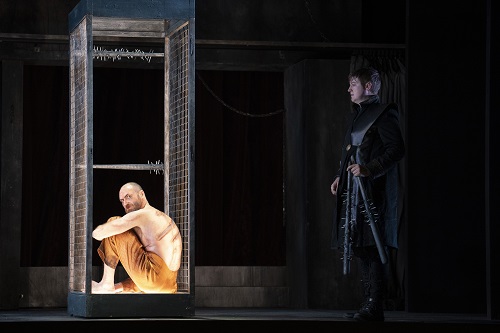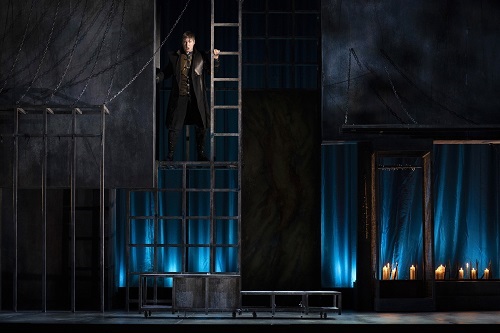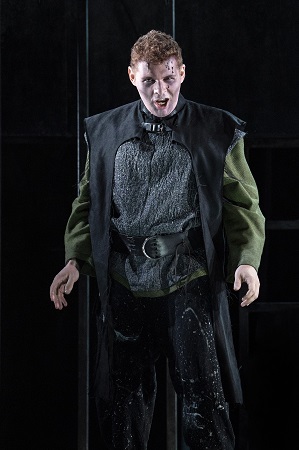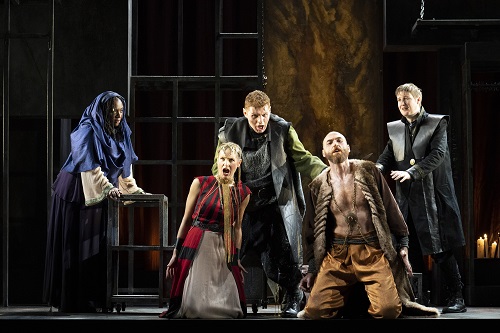The Mongol conqueror, Tamerlane (1336-1405), doesn’t have a good reputation. Also known as Timur, this son of a nomadic shepherd was a masterful military leader and tactician but is most oft remembered as a murderous tyrant whose gruesome military campaigns – victorious battles that made him the emperor of lands stretching from Delhi to the Mediterranean – left many millions slaughtered. In the West, the Tamerlane we picture is evil, ruthless and dangerous, a bloody-thirsty psychopath whose cruelty is legendary.
Such cruelty is evident from the opening moments of James Conway’s new production of Handel’s Tamerlano for English Touring Opera, when we see the captured Ottoman Sultan, Bajazet, imprisoned in a tiny, barbed cage, tormented by lice and having evidently been tortured. (The real Tamerlane is purported to have displayed his prisoner to the public in such a small cage, and to have made Bajazet’s wife wait on him naked at his table). It’s a powerful opening image and it establishes a sombre and distressing tone which persists throughout Conway’s production in which the emphasis is firmly on the psychological relationships between the characters – the realism of inner lives, not external events. Conway’s direction encourages the cast to interact unaffectedly and honestly, and the results are strikingly absorbing.

Designer Rebecca van Beeck presents us with a single set which serves as both throne room and prison – as Conway says, ‘throne rooms are prisons in this world’, though the abstraction of the design, and costumes which blend the modern and archaic, suggest that it could be our world, too. And, as is sadly all too apparent in Eastern Europe today, dangerous, volatile dictators are certainly not a thing of the past. The ambience is darkly despairing: Turner-like panels hang like lowering clouds, suggesting turmoil and tempest in both natural and human realms. Trellis grilles form a black scaffold. Tim van ’t Hof uses light and colour to stirring dramatic effect, bathing arias and scenes in glowing teal, indigo and crimson hues. A burning brazier evokes passion, anger and danger, but there are some softer touches too: to the rear, in a chapel-like space, candles form a carpet of flickering flames, suggesting that the spritual and sacred are not entirely extinguished by Tamerlano’s tyranny.

The agility that James Hall displayed last weekend, as Ottone, was in evidence again here, but it was in Andronico’s lyrical expressions of love for Asteria that Hall really excelled. The Greek prince’s anguish and sorrow were communicated with tremendous control and stamina, the melodic line flowing evenly and clearly, touchingly decorated. Andronico’s long aria at the close of Act 1 was epecially heart-touching, allowing too for intimations of hope amid his dilemmas and frustrations. The role was originally written for Senesino, and Hall seemed inspired by the former’s reputation for the pathetic mode, shaping beautifully elegant lines which conveyed both sincerity and unworldliness – the truth of his love but also his flaws, his equivocations and compromises.

Rodrigo Sosa Dal Pozzo’s rich, plump countertenor, with its strong lower register, conveyed Tamerlano’s absolute self-belief and blind confidence, and his vigorous delivery as he moved easily through the demanding passagework suggested both a wild unpredictability and his exasperation. The latter invoked, if not sympathy, then at least a little understanding of his foolishness and irritation. Wisely, Sosa Dal Pozzo didn’t physically overdo Tamerlano’s hysteria and hyperbole and instead let his singing, and an occasional glint of the eye, do the dramatic work.
Francesca Cuzzoni was the first Asteria, and the role is a terrific portrait of heroic feminine conviction. Ellie Laugharne’s soprano is quite light, but she shaped her lines into beautiful contours and absolutely convinced in her portrayal of both Asteria’s pain and her defiance. She proved a discerning, dignified actress and both Asteria’s Act 2 closing aria and her duet with Andronico – a rare ensemble – were transfixing musically and theatrically.

April Koyejo-Audiger’s Irene – the princess of the Greek Pontic kingdom of Trezibond whom Tamerlane has arranged to marry – was self-possessed and assured, and her tone comfortingly warm, in her contemplative Act 2 aria as she looked on aghast at the emotive extremes on display in this foreign land. The small role of Leone, Andronico’s confidant, was cut, which, although she makes only a small musical contribution, perhaps strengthened the impact of Irene’s role as, in Conway’s words, ‘the character from outside … an important reference to an outside world’ – though the omission did rob the final chorus of its bass line weight and shadow.

Bajazet was Handel’s first significant tenor role, written for the London debut of Francesco Borosini. Jorge Navarro Colorado compellingly conveyed the captured Sultan’s angry pride and righteousness, as well as the almost frightening fierceness of his love for his daughter – a love which is just as dangerous and damaging as that displayed by the other men who seek to claim her – in arias of tremendous virtuosity and pathos. The two qualities were combined in Bajazet’s closing sequence, in which he vows in fury to return as an avenging spirit, and bids a tender, regretful farewell to Asteria, wishing that he could grant her wish and take her life too. As the bitterness and self-absorption that had been evident from the first finally overflowed, it was an astonishingly powerful theatrical moment. And, if it inspired Tamerlano’s fearful change of heart and relinquishment of hatred, then the final chorus in which the protagonists vow to live in peace seemed one of shocked sombreness, not at all the conventional lieto fine.
The orchestral colouring in Tamerlano is fairly light, but Jonathan Peter Kenny was characteristically balletic in the pit, drawing lovely phrasing from the Old Street Band and some especially tender string playing.
Conway describes Tamerlano as ‘one of the most perfect and austere works of art’. It’s hard to disagree on the strength of this production, in which there is nothing irrelevant or irreverant, and which builds relentlessly and disturbingly towards Bajazet’s suicide. But it is the generosity of these singers’ performances, and their interpretative commitment, that both draws the listener into the appalling darkness and communicates the very beauty of that austerity – a starkness which paradoxically illuminates the richness and intensity of private feelings.
English Touring Opera’s 2022 Autumn Tour continues at various venues until 12th November.
Claire Seymour
Handel: Tamerlano
Bajazet – Jorge Navarro Colorado, Andronico – James Hall, Asteria – Ellie Laugharne, Tamerlano – Roderigo Sosa Dal Pozzo, Irene – April Koyejo-Audiger; Director – James Conway, Conductor – Jonathan Peter Kenny, Set & Costume Designer – Rebecca van Beeck, Lighting Designer – Tim van ’t Hof, The Old Street Band.
The Hackney Empire, London; Saturday 8th October 2022.
ABOVE: Jorge Navarro Colorado (Bajazet), James Hall (Andronico) (c) Richard Hubert Smith